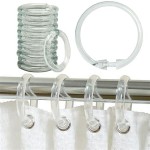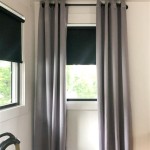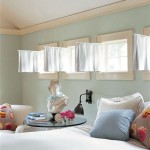Weights for the Bottom of Curtains: Maintaining Grace and Functionality
Curtains, with their ability to control light, offer privacy, and enhance aesthetics, are an integral part of many homes. However, without proper weights at the bottom, they can easily become dishevelled and detract from the intended elegance. These weights, typically sewn into the hem, play a crucial role in keeping curtains hanging beautifully and performing their functions effectively. This article will delve into the importance of curtain weights, explore different types available, and provide insights on choosing the right ones for your specific needs.
The Importance of Weights for Curtains
Curtain weights serve several essential purposes that contribute to their overall appearance and effectiveness. Firstly, they prevent the fabric from billowing and flapping uncontrollably, especially in drafty areas or when exposed to wind. This ensures that the curtains hang evenly and gracefully, maintaining a sleek and polished look. Secondly, weights prevent the curtains from bunching up at the bottom, particularly when they are drawn open. This is crucial for maintaining a clean and organized appearance, as well as for allowing easy access to windows and doors. Lastly, weights add a sense of solidity and structure to the curtains, giving them a more substantial feel and improving their overall quality. This is especially important for heavier fabrics that may naturally tend to sag.
Types of Curtain Weights: A Comprehensive Overview
A variety of curtain weights are available, each with distinct characteristics that cater to different needs and preferences. Some of the most common types include:
- Lead Weights: These traditional weights are widely used due to their effectiveness and affordability. Lead weights are typically encased in fabric or plastic and are sewn directly into the hem of the curtain. Their high density ensures optimal weight distribution and stability. However, lead weights are becoming less popular due to environmental concerns associated with the metal.
- Steel Weights: Steel weights offer a durable and environmentally friendly alternative to lead. They are typically smaller and lighter than lead weights but still provide sufficient weight for most curtains. Steel weights are often encased in fabric or plastic for a smooth finish and prevent the metal from rusting.
- Plastic Weights: Plastic weights are increasingly favored due to their lightweight nature and ease of handling. They come in various shapes and sizes, making them suitable for different curtain thicknesses and styles. While not as heavy as lead or steel, plastic weights can still effectively prevent billowing and bunching.
- Metal Beads: Metal beads, such as copper or brass, add a decorative element to curtains while also serving as weights. They can be strung along the hem or sewn directly into the fabric. Metal beads offer a more subtle and less noticeable weight option compared to other types.
- Sand Weights: Sand weights involve filling a fabric pocket sewn into the hem with sand. This method offers versatility and can be customized to achieve the desired weight. However, sand can shift over time, requiring occasional adjustments.
Choosing the Right Weights for Your Curtains
When selecting weights for your curtains, several factors need consideration:
- Curtain Fabric: The weight and texture of the fabric play a crucial role in determining the necessary amount of weight. Heavier fabrics like velvet or brocade require more substantial weights than lighter fabrics like silk or cotton.
- Curtain Length: Longer curtains naturally require more weight to prevent sagging. Consider the overall height of the curtain and the desired drape to estimate the appropriate weight.
- Curtain Style: Different curtain styles have varying degrees of fullness and movement. For instance, billowing curtains may require more weight than flat-panel curtains.
- Environmental Factors: The location of the curtains and the prevailing wind conditions are additional factors to consider. For exposed windows, heavier weights may be necessary to ensure stability and prevent excessive movement.
By carefully considering these factors, you can choose the appropriate weights that will enhance the beauty and functionality of your curtains. Remember, the goal is to achieve a graceful drape without sacrificing the intended elegance and flow of the fabric.
In conclusion, curtain weights are an essential component for maintaining the desired appearance and functionality of curtains. From preventing billowing and bunching to adding structural stability, they contribute significantly to the overall aesthetic appeal of any room. Understanding the different types of weights available and considering the specific needs of your curtains allows you to make an informed choice that ensures a beautiful and well-balanced design.

Curtains Don T Drape Well Try These Easy Homemade Diy Curtain Weights Robin Kramer Writes

How To Attach Drapery Weights Ofs Maker S Mill

Curtain Bottom Weight Chain Add It To Your For A More Even Fl The Drapery King Toronto

20 Pcs Curtain Bottom Weights Clips Window Water Drop Pendants

20pcs Magnetic Curtain Weights Drapery Magnet Shower Bottom For Tablecloth White

Curtain Bottom Weight Chain Add It To Your For A More Even Fl The Drapery King Toronto

Windowshade Curtain Drape Weights 4 Pack Natural

How To Attach Drapery Weights Ofs Maker S Mill

Add Weights To The Bottom Of Curtains Lead Free Sausage Bead Weight Heavy Rope For Drapes Light Weighted Etsy Hong Kong

Add Weights To The Bottom Of Curtains Lead Free Sausage Bead Weight Heavy Rope For Drapes Light Weighted Etsy Hong Kong








